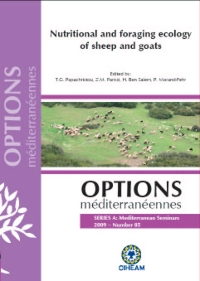| Article précédent | p. 105-109 | Article suivant |
The grazing preferences of sheep on pastures containing drunken horse grass (Achnatherum inebrians) in Xinjiang province, China
Drunken horse grass (DHG) [Achnatherum inebrians (Hance) Keng] is a rapidly spreading perennial grass weed of western China. DHG contains an endophytic fungus (Neotyphodium spp.) which produces neurotoxins which cause morbidity in animals grazing these plants. The present study investigates the effects of fungicide (propiconizole) application, seed heat treatment, N and P fertiliser and water application on the growth and potential toxicity of DHG for grazing sheep in Xinjiang province of PRC. Two experiments are reported in which Merino/Xinjiang fine-wool sheep are grazed on pasture plots (5 × 10 m) of DHG and native grasses to which the above treatments were applied. Field application of fungicide did not effectively control DHG endophyte, reducing infection from 92 to 60%, and ergonovine concentrations from 358 to 273 mg/kg DM. Sheep selected other grasses in preference to DHG which formed on average 27% of DM eaten. The levels of endophyte in DHG did not affect preference, nor did the application of N and P fertiliser. In the second experiment, heat treatment of DHG seed prior to planting significantly reduced both endophyte (93 vs 5%) and ergonovine (308 vs 10 mg/kg DM) in DHG being grazed. Sheep consumed more DHG (54% removed, 61% in the diet) than did sheep grazing infected DHG pastures (38% removed, 51% in the diet). It was concluded that heat-treatment of seed is a cheap, practical and effective way of producing toxin-free DHG pastures in this area, and since neither plant survival nor responsiveness to fertiliser and irrigation was affected by endophyte presence, toxin-free DHG pastures may be a valuable new grazing resource for this low rainfall area. The present study also showed that while sheep will eat some DHG, they have a greater preference for other grasses, which increases as the proportion of other grasses in the sward increases.
Achnatherum inebrians (Hance) Keng (DHG) est une mauvaise herbe qui se propage rapidement en Chine de l'Ouest. DHG renferme un champignon endophytique (Neotyphodium spp.) qui produit des neurotoxines causant la morbidité chez les animaux consommant ces plantes. Cette étude évalue les effets de l'application d'un fongicide (propiconizole), du traitement à la chaleur des semences, de la fertilisation azotée et phosphatée, et de l'irrigation sur la croissance et le potentiel de toxicité du DHG pour des ovins sur parcours dans la province de Xinjiang de la Chine. Deux essais ont été conduits sur des moutons à laine fine placés sur des parties (5 × 10 m) du parcours de DHG et de mauvaises herbes naturelles qui ont été soumises aux traitements sus-indiqués. Le traitement du parcours par le fongicide n'a pas éliminé le DHG endophyte. En effet, il a réduit l'infestation de 92 à 60%, et les concentrations d'ergonovine de 358 à 273 mg/kg MS. Le mouton a sélectionné et a préféré d'autres herbes à la DHG qui représente en moyenne 27% de la matière sèche de la biomasse consommée. Les niveaux d'endophyte dans DHG n'ont pas affecté la préférence. Il en est de même pour la fertilisation azotée et phosphatée. Dans le deuxième essai, le traitement à la chaleur des semences de DHG avant semis a réduit l'endophyte (93 vs 5%) et l'ergonovine (308 vs 10 mg/kg MS) dans DHG pâturé. Les moutons ont consommé plus de DHG (54% prélevés, 61% dans la ration) que ceux pâturant dans un parcours infesté de DHG (38% prélevés, 51% dans la ration). En conclusion, il apparaît que le traitement à la chaleur des semences n'est pas coûteux et constitue une voie pratique et efficace pour l'obtention d'un pâturage de DHG dépourvu de toxines dans la zone d'étude. Par ailleurs, puisque la survie des plantes et la réponse aux fertilisants et à l'irrigation ont été affectées par la présence d'endophyte, les pâturages de DHG débarrassés de toxines peuvent être considérés comme étant une nouvelle et prometteuse ressource pastorale dans cette zone à faible pluviométrie. Cette étude a aussi montré que le mouton consommera une faible quantité de DHG mais aura une plus forte préférence pour d'autres plantes herbacées, qui augmentera avec l'augmentation de la proportion de ces plantes dans la pelouse.
- [ Afficher ]
- [ Télécharger ]
- [ Exporter la citation ]
Vous pouvez télécharger la citation au format :
- [ Imprimer ]
-
Mots-clés
ACHNATHERUM INEBRIANS, CHAMPIGNON TOXIQUE, CHINE, ENDOPHYTE, FONGICIDE, MAUVAISE HERBE, OVIN, PATURAGE, PLANTE HERBACEECiter cet article
Norton B.W., Li X.S., Fletcher I. The grazing preferences of sheep on pastures containing drunken horse grass (Achnatherum inebrians) in Xinjiang province, China. In : Papachristou T.G. (ed.), Parissi Z.M. (ed.), Ben Salem H. (ed.), Morand-Fehr P. (ed.). Nutritional and foraging ecology of sheep and goats. Zaragoza : CIHEAM / FAO / NAGREF, 2009. p. 105-109. (Options Méditerranéennes : Série A. Séminaires Méditerranéens; n. 85). 12. Seminar on: Nutritional and Foraging Ecology of Sheep and Goats, 2007/10/11-13, Thessaloniki (Greece). http://om.ciheam.org/om/pdf/a85/00800992.pdf



